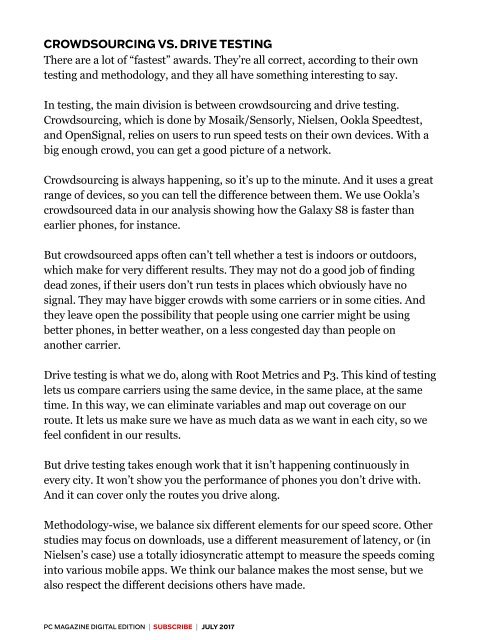PC Magazine July 2017
PC Magazine July 2017 issue, we feature PCMag's eighth annual Fastest Mobile Networks report. Testers drove within and between 30 cities, running speed tests and collecting more than 124,000 network-speed data points. Find out which carrier leads the pack—and where. The results may surprise you! PC Magazine is America's #1 technology magazine, delivering authoritative, lab-based comparative reviews of technology products and services to more than 6.6 million professionals every issue. PC Magazine is the only publication with in-depth reviews and accurate, repeatable testing from PC Magazine Labs placed in the unique context of today's business technology landscape.
PC Magazine July 2017 issue, we feature PCMag's eighth annual Fastest Mobile Networks report. Testers drove within and between 30 cities, running speed tests and collecting more than 124,000 network-speed data points. Find out which carrier leads the pack—and where. The results may surprise you!
PC Magazine is America's #1 technology magazine, delivering authoritative, lab-based comparative reviews of technology products and services to more than 6.6 million professionals every issue. PC Magazine is the only publication with in-depth reviews and accurate, repeatable testing from PC Magazine Labs placed in the unique context of today's business technology landscape.
You also want an ePaper? Increase the reach of your titles
YUMPU automatically turns print PDFs into web optimized ePapers that Google loves.
CROWDSOURCING VS. DRIVE TESTING<br />
There are a lot of “fastest” awards. They’re all correct, according to their own<br />
testing and methodology, and they all have something interesting to say.<br />
In testing, the main division is between crowdsourcing and drive testing.<br />
Crowdsourcing, which is done by Mosaik/Sensorly, Nielsen, Ookla Speedtest,<br />
and OpenSignal, relies on users to run speed tests on their own devices. With a<br />
big enough crowd, you can get a good picture of a network.<br />
Crowdsourcing is always happening, so it’s up to the minute. And it uses a great<br />
range of devices, so you can tell the difference between them. We use Ookla’s<br />
crowdsourced data in our analysis showing how the Galaxy S8 is faster than<br />
earlier phones, for instance.<br />
But crowdsourced apps often can’t tell whether a test is indoors or outdoors,<br />
which make for very different results. They may not do a good job of finding<br />
dead zones, if their users don’t run tests in places which obviously have no<br />
signal. They may have bigger crowds with some carriers or in some cities. And<br />
they leave open the possibility that people using one carrier might be using<br />
better phones, in better weather, on a less congested day than people on<br />
another carrier.<br />
Drive testing is what we do, along with Root Metrics and P3. This kind of testing<br />
lets us compare carriers using the same device, in the same place, at the same<br />
time. In this way, we can eliminate variables and map out coverage on our<br />
route. It lets us make sure we have as much data as we want in each city, so we<br />
feel confident in our results.<br />
But drive testing takes enough work that it isn’t happening continuously in<br />
every city. It won’t show you the performance of phones you don’t drive with.<br />
And it can cover only the routes you drive along.<br />
Methodology-wise, we balance six different elements for our speed score. Other<br />
studies may focus on downloads, use a different measurement of latency, or (in<br />
Nielsen’s case) use a totally idiosyncratic attempt to measure the speeds coming<br />
into various mobile apps. We think our balance makes the most sense, but we<br />
also respect the different decisions others have made.<br />
<strong>PC</strong> MAGAZINE DIGITAL EDITION I SUBSCRIBE I JULY <strong>2017</strong>





